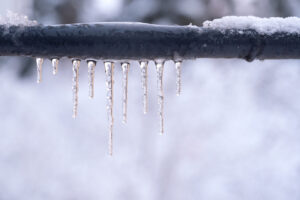Responsibilities and Liability in Thawing Frozen Water Lines
 Guest post by Julie Jelen, LMCIT senior loss control consultant
Guest post by Julie Jelen, LMCIT senior loss control consultant
Public works professionals understand the critical role of pre-planning in winter months. By providing helpful tips on city websites or through utility bill inserts, city staff can equip residents with the knowledge they need to protect their water lines from freezing and avoid costly, burst pipes.
How to Prepare for Freezing Water Lines This Winter
• Stay Ahead with Weather Monitoring – Watch for cold weather forecasts and act early to protect your pipes. The sooner you prepare, the better.
• Circulate Warm Air – Open doors to areas like basements and attics where pipes are exposed, allowing warm air to circulate and keep temperatures above freezing.
• Open Cabinet Doors – Open under-sink cabinet doors, especially in kitchens and bathrooms, to allow warm air to reach the pipes underneath.
• Use Snow as Insulation – Deep snow can act as a natural insulator for outside pipes, reducing the risk of freezing.
• Maintain Your Thermostat – Keep your thermostat set to at least 55°F. This will ensure that the temperature inside your home stays warm enough to protect your pipes.
• Run Cold Water – Let a small stream of cold water flow from the faucet. This reduces pressure in the pipes and helps prevent freezing.
• Leave Faucets Dripping – If you’re leaving your home during cold weather, leave your faucets running to keep the water moving.
• Notify Your Utility Company – If you plan to leave a faucet running, inform your utility company to avoid confusion over your water usage.
• Seal Gaps and Insulate Pipes – Prevent cold drafts from reaching your pipes by sealing any cracks or gaps, and insulate exposed pipes to protect them from freezing.
• Be Ready for Emergencies – In the event of frozen pipes, turn off the water supply and begin thawing the pipes carefully. If necessary, call a plumber for assistance.

What to Do If Your Pipes Freeze
If you suspect your water pipes have frozen, quick action is essential to minimize damage.
• Turn Off the Water Supply – Immediately shut off the main water valve to prevent flooding if a pipe bursts during thawing. This will help reduce water damage inside your home.
• Locate the Frozen Pipe – Identify which section of the pipe is frozen. Areas commonly affected include attics, basements, and exterior walls. Focus on thawing the frozen section.
• Thaw the Pipe Safely
- Heat Tape: Use heat tape or heating cables specifically designed for pipes. Wrap them around the frozen pipe to safely thaw it.
- Space Heater: A space heater can warm the area around the frozen pipe. Always keep space heaters away from flammable materials and never leave them unattended.
- Hair Dryer: If you can access the frozen pipe, use a hair dryer to warm it. Start from the farthest point from the faucet and work towards it.
- Prioritize Safety: Follow the safety instructions from the Consumer Product Safety Commission (CPSC) and Underwriters Laboratories (UL) to avoid fire hazards.
• Open the Faucet – As the pipe thaws, open the faucet connected to it. This helps the water flow once the ice melts, relieving pressure and aiding the thawing process.
• Watch for Water Flow Risks – Running water to prevent freezing can lead to sewer or septic backups, especially in older systems. Be vigilant and watch for signs of backup.
• Call a Professional if Needed – If you can not locate or safely thaw the frozen pipe or are uncomfortable handling the situation, call a professional plumber. Ensure the plumber is insured before allowing them to work on your pipes.
• Prevent Future Freezing – Insulate vulnerable pipes in unheated spaces like attics, basements, and garages. Open cabinet doors in kitchens and bathrooms to allow warmer air to circulate the pipes. Install heat tape or foam pipe insulation in at-risk areas to protect them from the cold.

City Responsibilities
Cities are responsible for exercising reasonable care in the construction, maintenance, and inspection of utilities, including water systems. Freezing water and sewer line issues are often the result of extreme cold weather, which is beyond the city’s control and typically not grounds for negligence or liability for damages.
However, if multiple homes are affected, public health and safety concerns may arise. In these cases, the city may need to enter private properties to thaw frozen lines. To do so, it is advisable to consult with the city attorney and obtain a waiver from property owners before proceeding. A sample Waiver of Liability and Hold Harmless Agreement for thawing water lines is available from the League. For more details, contact your loss control consultant.
By taking proactive steps and educating residents, you can help minimize the risk of frozen pipes and ensure that public and private interests are protected during the winter.

